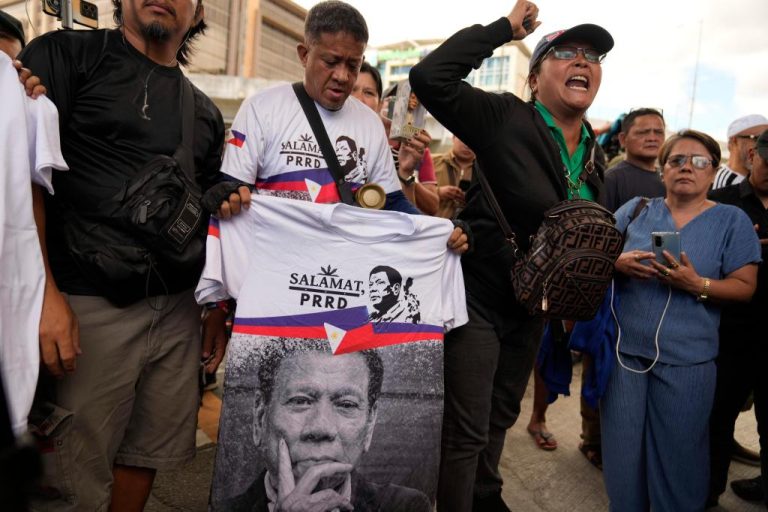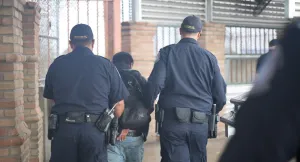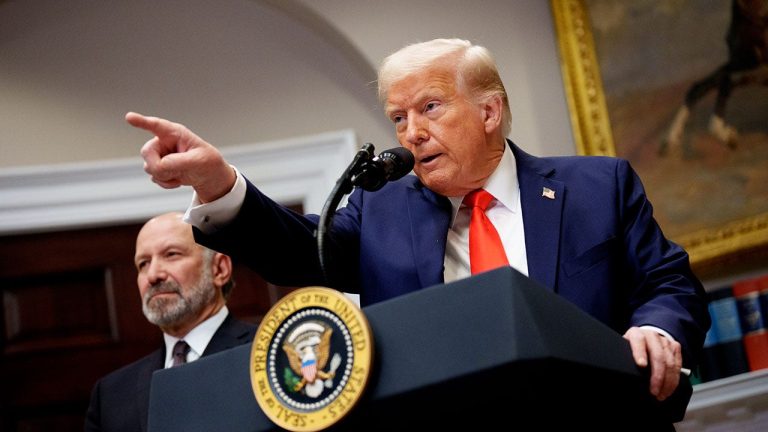After two years of walking halfway around the world searching for her mother and a new home, a 10-year-old Syrian girl made it to the US-Mexico border.
She reached gate 36 of the port of entry in the border fence, where crowds of asylum seekers and refugees have crossed into the US.
Standing on Mexican soil, she waved at a clutch of Venezuelans sitting amid trash and pieces of clothing on the north bank of the Rio Grande. Two children by the river waved back – in awe of her 12-foot height and larger-than-life features.
Like her, they were just a few feet from reaching Texas and looked conflicted, confronted by razor wire and a heavily guarded border. Unlike her, they did not have authorization from the authorities to cross.
The name of the “girl” is Little Amal and she is a puppet, towering but childlike, the central figure of an international theater arts project called The Walk, designed to project hope, encouragement and solidarity to those fleeing war, violence, poverty and persecution.
The puppet’s creators began propelling her on a winding odyssey that started at the Syrian border with Turkey in 2021. Representing an unaccompanied refugee searching for family and community, she visited more than 90 cities, with a mixed reception, on a trek to the UK.
In September she began a new 6,000-mile journey through 35 US cities.
Little Amal’s journeys aim to evoke empathy and compassion for the struggles of displaced people. In the twin cities of El Paso, Texas, and Juárez, Mexico, bisected by the border, she was also celebrating and paying tribute to the local communities, project producer David Lan said.
“How amazing it is to look at El Paso and Juárez’s relationship. It’s poetic, but also tragic,” he said.
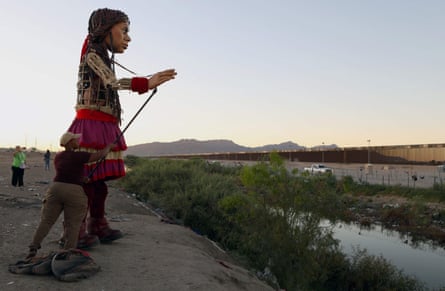
The interdependent cities share the river and their history, culture and language.
They have also faced the same challenges in coping with tens of thousands of people from other parts of Mexico, Central and South America and dozens of other countries arriving and needing help en route to safe harbor in the US.
Locals have witnessed scenes of humanitarian hardship and even death, affecting migrants but also residents.
Before crossing into Mexico last week, Little Amal visited the site of the racially motivated mass shooting at the Walmart in El Paso in 2019. The 23 people killed in that attack included Mexicans and Americans from both sides of the border in a tragedy which strained but did not break the communities’ resilience and binational ties.
At the Healing Garden national memorial to honor the victims, Little Amal paid tribute to the victims, in an event organized by Creative Kids, an organization serving children and families directly affected by the shooting.
Seven-year-old Olivia Izquierdo couldn’t refrain from shouting an exuberant “Welcome to El Paso!” during a moment of silence.
Then the little girl reached up to give a huge bunch of paper flowers to Little Amal. The four puppeteers, operating 70 pounds of cane and carbon fiber, manipulated the puppet so that it placed the bouquet beneath the illuminated memorial installation.
Little Amal didn’t give a speech – she doesn’t talk but relies on her expressive face and delicate hand gestures to communicate feelings of empathy, tenderness, joy or sadness, often clearly transcending the limits of spoken words and language.
“Amal is a beacon of hope, resilience and forgiveness,” said Andrea Gates, co-founder of Creative Kids. “And that is what this community represents.”
She was warmly embraced at free public events and festivals during her two-day, cross-border visit. A mariachi band serenaded Little Amal in downtown El Paso at a festival to highlight the plight of the displaced, where she danced and strolled with migrant children who had made cardboard versions of hummingbirds, which migrate between South and North America.
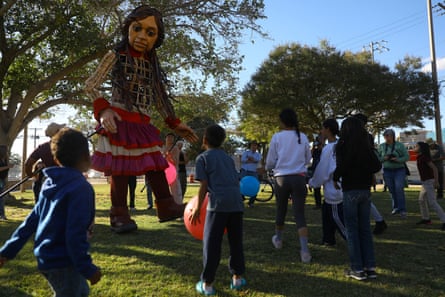
Little Amal played with the kids on swings and a slide at the park, before celebrating her “birthday” with a traditional Mexican celebration in which she hit a piñata.
Then as she walked, representatives of community and religious organizations gave her food and water, emulating how volunteers help hungry and thirsty migrants on their journeys.
after newsletter promotion
Francielis Montoya saw herself in Little Amal. She said El Paso is where she had felt the most welcomed and helped among all the cities in Argentina, Colombia and Bolivia where she’s lived since fleeing extreme poverty in her native Venezuela in 2014.
“I felt like her, accepted,” said Montoya, 23, who was with her one-year-old boy and four-year-old twin girls at the park.
She was staying at Casa Carmelita, a local shelter, after crossing the border and while making plans to travel to Virginia.
Little Amal journeyed the next day to Juárez, her first time in Mexico and the first Latin American and Spanish-speaking country of her long journey.
She joined hundreds of children in a carnival-like celebration at the Plaza de la Mexicanidad, just over the Mexican side of the border. She interacted with children and adults, most of whom took selfies and wanted a chance to touch the puppet, and she also danced with four Mexican folkloric dancers.
“Mexico is your house and Juárez your home,” Rubí Enríquez, head of the municipal family and children’s services and wife of the city’s mayor, said.
Watching the evocative scene was Monserrat Meléndez, who works for Caena, a Juárez organization that helps migrant children find schooling.
For years, the city has been a refuge for displaced children who, like Little Amal, fled violence, not only in other countries but also inside Mexico, said Meléndez.
She currently teaches first grade to Mexican children who, with their families, have left their hometowns in the Mexican states of Michoacán, Guerrero and Chiapas because of drug-related gang violence, she said.
“It’s heartbreaking what these children go through, but seeing this puppet and interacting with it is a positive distraction for them,” she said.
Although she’s hard to miss, even from a distance, Little Amal suddenly looked tiny as she contemplated the nearby huge red stylized X sculpture, La Equis, by Enrique Carbajal González, alias Sebastian, which represents the historical intersection in Mexico of Indigenous people and the Spanish. It overlooks the border and Little Amal ran north to peek from Juárez into El Paso, then appeared daunted by the border fence blocking her path.
She later rode along a Juárez highway parallel to the fence, waving at surprised drivers, then crossed back into the US through an international port of entry that night.
Little Amal’s last stop before leaving for California and then seven more Mexican cities was the Sacred Heart Catholic church shelter in El Paso, where thousands of migrants have passed through.
One resident, Esaú Colindres, 21, admitted being scared at the uncertain path ahead of him since he’d crossed the border without authorization five days earlier. But he said what he’d endured in his native Honduras was much worse, where he was bullied and threatened for living with his same-sex partner.
“Amal made me feel happy and at peace again. For a moment, I forgot all my hardships,” Colindres said. “She gave me hope.”


